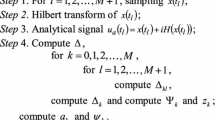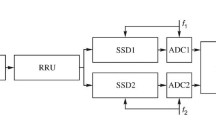Abstract
This paper is concerned with the estimation of amplitude and phase of an analog multi-harmonic signal based on a series of differential values of the signal. To this end, assuming that the signal fundamental frequency is known beforehand (i.e., estimated in an independent stage), a complexity-reduced scheme is proposed here. The reduction in complexity is achieved owing to completely new analytical and summarised expressions that enable quick estimation at a low numerical error. The proposed algorithm for the calculation of the unknown parameters requires O((2M)2) flops, while the straightforward solution of the obtained equations takes O((2M)3) flops, where M is number of harmonic coefficients. It is proved that the estimation performance of the proposed algorithm can attain Cramer-Rao lower bound (CRLB) for sufficiently high signal-to-noise ratios. It is applied in signal reconstruction, spectral estimation, system identification, as well as in other important signal processing problems. The paper investigates the errors related to the signal parameter estimation, and computer simulation demonstrates the accuracy of these algorithms.







Similar content being viewed by others
References
Proakis, J. G., & Manolakis, D. G. (1996). Digital signal processing: Principles, algorithms, applications (3rd ed.). Englewood Cliffs: Prentice-Hall.
Lai, L. L., Chan, W. L., Tse, C. T., & So, A. T. P. (1999). Real-time frequency and harmonic evaluation using artifical neural networks. IEEE Transactions on Power Delivery, 14(1), 52–59.
Prendergast, R. S., Levy, B. C., & Hurst, P. J. (2004). Reconstruction of band-limited periodic nonuniformly sampled signals through multirate filter banks. IEEE Transactions on Circuits and Systems I, 51(8), 1612–1622.
Marziliano, P., Vetterli, M., & Blu, T. (2006). Sampling and exact reconstruction of bandlimited signals with additive shot noise. IEEE Transactions on Information Theory, 52(5), 2230–2233.
Margolis, E., & Eldar, Y. C. (2004). Reconstruction of nonuniformly sampled periodic signals: algorithms and stability analysis. Electronics, Circuits and Systems, 2004. ICECS 2004. Proceedings of the 2004 11th IEEE International Conference, 13–15 Dec. 2004, pp. 555–558.
Sun, W., & Zhou, X. (2002). Reconstruction of band-limited signals from local averages. IEEE Transactions on Information Theory, 48(11), 2955–2963.
Petrovic, P. (2012). New method and circuit for processing of band-limited periodic signals. Signal, Image and Video Processing, 6(1), 109–123. Springer.
Muciek, A. K. (2007). A method for precise RMS Measurements of periodic signals by reconstruction technique with correction. IEEE Transactions on Instrumentation and Measurement, 56(2), 513–516.
Bos, A. V. D. (1989). Estimation of Fourier coefficients. IEEE Transactions on Instrumentation and Measurement, 38(5), 1005–1007.
Bos, A. V. D. (1995). Estimation of complex Fourier coefficients. IEE Proceedings Control Theory and Applications, 142(3), 253–256.
Pintelon, R., & Schoukens, J. (1996). An improved sine-wave fitting procedure for characterizing data acquisition channels. IEEE Transactions on Instrumentation and Measurement, 45(2), 588–593.
Xiao, Y., Tadokaro, Y., & Shida, K. (1999). Adaptive algorithm based on least mean p-power error criteterion for Fourier analysis in additive noise. IEEE Transactions on Signal Processing, 47(4), 1172–1181.
Arpaia, P., Cruz Serra, A., Daponte, P., & Monteiro, C. L. (2001). A critical note to IEEE 1057-94 standard on hysteretic ADC dynamic testing. IEEE Transactions on Instrumentation and Measurement, 50(4), 941–948.
Seber, G. (1977). Linear regression analysis. New York: Wiley.
Reeves, S. J., & Heck, L. P. (1995). Selection of observations in signal reconstruction. IEEE Transactions on Signal Processing, 43(3), 788–791.
Poberezhskiy, Y. S., & Poberezhskiy, G. Y. (2004). Sampling and signal reconstruction circuits performing internal antialiasing filtering and their influence on the design of digital receivers and transmitters. IEEE Transactions on Circuits and Systems I, 51(1), 118–129.
Petrovic, P. (2004). New digital multimeter for accurate measurement of synchronously sampled AC signals. IEEE Transactions on Instrumentation and Measurement, 53(3), 716–725.
Xiao, Y., Ward, R. K., Ma, L., & Ikuta, A. (2005). A new LMS-based Fourier analyzer in the presence of frequency mismatch and applications. IEEE Transactions on Circuits and Systems I, 52(1), 230–245.
Xiao, Y., Ward, R. K., & Xu, L. (2003). A new LMS-based Fourier analyzer in the presence of frequency mismatch. ISCAS’03, Proceedings of the 2003 International Symposium on Circuits and Systems, 4, 369–372.
So, H. C., Chan, K. W., Chan, Y. T., & Ho, K. C. (2005). Linear prediction approach for efficient frequency estimation of multiple real sinusoids: algorithms and analyses. IEEE Transactions on Signal Processing, 53(7), 2290–2305.
Wu, B., & Bodson, M. (2002). Frequency estimation using multiple source and multiple harmonic components. American Control Conference, 2002. Proceedings of the 2002, vol. 1, 8–10 May 2002, pp. 21–22.
Tan, L., & Wang, L. (2011). Oversampling technique for obtaining higher order derivative of low-frequency signals. IEEE Transactions on Instrumentation and Measurement, 60(11), 3677–3684.
Daboczi, T. (1998). Uncertainty of signal reconstruction in the case of jitter and noisy measurements. IEEE Transactions on Instrumentation and Measurement, 47(5), 1062–1066.
Wang, G., & Han, W. (1999). Minimum error bound of signal reconstruction. IEEE Signal Processing Letters, 6(12), 309–311.
Nigham, N. J. (2002). Accuracy and stability of numerical algorithms (2nd ed.). Philadelphia: SIAM.
Feichtinger, H. G. (1991). Reconstruction of band-limited signals from irregular samples, a short summary, 2nd International Workshop on Digital Image Processing and Computer Graphics with Applications, pp. 52–60.
Cooklev, T. (2006). An efficient architecture for orthogonal wavlet transforms. IEEE Signal Processing Letters, 13(2), 77–79.
Schoukens, J., Rolain, Y., Simon, G., & Pintelon, R. (2003). Fully automated spectral analysis of periodic signals. IEEE Transactions on Instrumentation and Measurement, 52(4), 1021–1024.
Reeves, S. J. (1999). An efficient implementation of the backward greedy algorithm for sparse signal reconstruction. IEEE Signal Processing Letters, 6(10), 266–268.
Kay, S. M. (1988). Modern spectral estimation: Theory and applications. Englewood Cliffs: Prentice-Hall.
Stoica, P., Li, H., & Lim, J. (2000). Amplitude estimation of sinusoidal signals: survey, new results, and an application. IEEE Transactions on Signal Processing, 48(2), 338–352.
Belega, D., Dallet, D., & Slepicka, D. (2010). Accurate amplitude estimation of harmonic components of incoherently sampled signals in the frequency domain. IEEE Transactions on Instrumentation and Measurement, 59(5), 1158–1166.
Pantazis, Y., Roces, O., & Stylianou, Y. (2010). Iterative estimation of sinusoidal signal parameters. IEEE Signal Processing Letters, 17(5), 461–464.
Hidalgo, R. M., Fernandez, J. G., Rivera, R. R., & Larrondo, H. A. (1996). A simple adjustable window algorithm to improve FFT measurements. IEEE Transactions on Instrumentation and Measurement, 51(1), 31–36.
Agrež, D. (2002). Weighted multi-point interpolated DFT to improve amplitude estimation of multi-frequency signal. IEEE Transactions on Instrumentation and Measurement, 51, 287–292.
Agrež, D. (2005). Improving phase estimation with leakage minimisation. IEEE Transactions on Instrumentation and Measurement, 54(4), 1347–1353.
Tse, N. C. F., & Lai, L. L. (2007). Wavelet-based algorithm for signal analysis. EURASIP Journal on Advances in Signal Processing, Article ID 38916, 10 pages.
Acknowledgments
The author wishes to thank to the Ministry of Education and Science of the Republic of Serbia for its support of this work provided within the projects 42009 and OI-172057.
Author information
Authors and Affiliations
Corresponding author
Appendix
Appendix
For 1 ≤ p ≤ 2M ∧ 1 ≤ q ≤ M:
It follows that:
where Δ (r,s)2M + 1,M + 1 is the determinant obtained from Δ 2M + 1,M + 1 after the r row and s column have been eliminated.
When we determinate Δ (r,s)2M + 1,M + 1 , we must eliminate r row and s column from Δ 2M + 1,M + 1, and if Δ 2M + 1,M + 1 is developed by r row, what we obtain is that D r,s = (−1)r + s Δ (r,s)2M + 1,M + 1 is the coefficient in x s − 1 r (1 ≤ s ≤ M), i.e. the coefficient beside x s r if M + 1 ≤ s ≤ 2M.
Here is:
If we introduce the following symbols:
It follows that:
We can write that:
From this, it follows that:
We can write that:
It follows that:
If we introduce the following symbols:
It follows that:
In addition, for:
Now, we can determine co-factors F q p for 1 ≤ p ≤ 2M; M + 1 ≤ q ≤ 2M, and F M + q p for 1 ≤ q ≤ M. As above, we obtain that:
From this, it follows that:
Rights and permissions
About this article
Cite this article
Petrović, P.B. New Procedure for Estimation of Amplitude and Phase of Analog Multiharmonic Signal Based on the Differential Irregular Samples. J Sign Process Syst 81, 11–27 (2015). https://doi.org/10.1007/s11265-014-0892-1
Received:
Revised:
Accepted:
Published:
Issue Date:
DOI: https://doi.org/10.1007/s11265-014-0892-1




